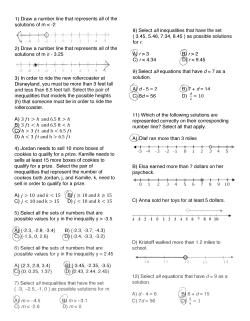
18.022 2014, Homework 9. Due Wednesday, November 12
18.022 2014, Homework 9. Due Wednesday, November 12th
Collaboration on homework is encouraged, but individually written solutions are
required. Also, it is mandatory to name all collaborators and sources of information
on each assignment. Any such named source may be used.
Each question is worth seven points.
(1) Let f : R2 → R be given by
(
f (x, y) =
sin x
x
1
x 6= 0
x = 0.
Note that f is continuous. Let D = {(x, y) ∈ R2 : 0 ≤ y ≤ π, y ≤ x ≤ π}.
(a) Write D as a type 1 elementary region.
(b) Note that there is no elementary anti-derivative for sin x/x. Still,
calculate
ZZ
f (x, y)dxdy.
D
(2) The Expensevier Publishing Company sells subscriptions to the Annals
of Integration by Parts (AIP) and the Journal of Lagrange Multipliers
(JLM). They have hired the Konman & Schwindler Consulting Company
to perform market research. The latter have returned with two functions
f, g : [0, C] → [0, 1], such that f (x) (respectively, g(x)) is the fraction of N
potential customers to whom an AIP (respectively, JLM) subscription is
worth at least x dollars. They have also discovered that these valuations
are “independent”: this means that the fraction of potential customers to
whom an AIP subscription is worth at least x dollars and to whom a JLM
subscription is worth at least y dollars is k(x, y) = f (x) · g(y).
Assume that f and g are C 1 , so that f 0 and g 0 exist and are continuous.
Assume that f (0) = g(0) = 1 (i.e., a subscription is worth at least zero
to everyone) and that f (C) = g(C) = 0 (i.e., there is no-one to whom a
subscription is worth more than C dollars).
Assume also that an (electronic) subscription costs nothing to produce,
so that Expensevier makes a full x dollars for each subscription it sells for
x dollars.
As in question 2 of the previous problem set, assume that a customer
will buy a product priced at x dollars iff the product it worth at least x to
her / him.
You can read about the inspiration for this problem here: http://en.
wikipedia.org/wiki/The_Cost_of_Knowledge.
(a) Explain why, for 0 ≤ a, b ≤ C,
ZZ
k(a, b) = f (a) · g(b) =
f 0 (x) · g 0 (y) dxdy
S
where S = [a, C] × [b, C].
Omer Tamuz. Email: tamuz@mit.edu.
1
2
(b) Show that “independent valuations” mean that of the people to whom
an AIP subscription is worth at least x dollars, the fraction of those
to whom a JLM subscription is worth at least y dollars is still g(y), as
it is in the general population.
(c) What is the profit P (x, y) that Expensevier will reap from setting a
fixed price of x dollars for AIP and a fixed price of y dollars for JLM?
(d) For 0 ≤ z ≤ 2C, let
Dz = {(x, y) ∈ [0, C] × [0, C] : x + y ≥ z}
be the set of price pairs whose sum is at least z. Using the definition
of double integrals, give an intuitive explanation (i.e., an informal explanation that is not a proof) for why the total number of customers
to whom both subscriptions together are worth at least z dollars is
ZZ
N
f 0 (x)g 0 (y) dxdy.
Dz
(e) Assume henceforth that C = 1, 000, 000, that N = 1, 000, and that
g(x) = f (x) = 1 − x/C.
Konman suggests that Expensevier set a fixed price xm for AIP and
a fixed price ym for JLM. Which prices should Expensevier set to
maximize its profits? What will its profits be? (Hint: use question 2
in the previous problem set.)
(f) Schwindler suggests to instead try bundling: a customer will only be
allowed to buy both subscriptions, for a fixed price z. Assuming 0 ≤
z ≤ C, what bundle price will maximize Expensevier’s profit? What
will Expensevier’s profit be (rounded to the nearest million dollars) at
this price, if, as above, C = 1,000,000 and N = 1,000 ?
(3) Let d : [0, 2π] → [0, 1] be a continuous function such that d(0) = d(2π), let
Df = {(r, θ) : r ≤ d(θ)} be a bounded domain on the plain, given in polar
coordinates. Let h > 0, and let W = {(r, θ, z) : 0 ≤ z ≤ h, r ≤ d(θ) · z/h}.
Note that W is given in cylindrical coordinates.
The center of mass of W is the point (xc , yc , zc ), where
ZZZ
1
x dxdydz
xc =
vol(W )
Z Z ZW
1
yc =
y dxdydz
vol(W )
W
ZZZ
1
zc =
z dxdydz
vol(W )
W
(a) If d(θ) = 1, what shape is W ? Describe W for general d.
(b) Calculate A, the area of Df . Express it as a one dimensional integral
of an expression involving d.
(c) Calculate vol(W ) in terms of A.
(d) Calculate zc .
(e) Assume now that d(θ + π) = d(θ) for all θ ∈ [0, 2π]. Calculate xc and
yc .
3
(4) Let f (x, y) = sin(x + y) cos(x − y). Let D = {(x, y) ∈ R2 : x2 + y 2 ≤ 1}
be the unit disk. In this question we will calculate
ZZ
f (x, y) dxdy.
D
(a) Apply the coordinate transformation u = √12 (x+y) and v = √12 (x−y).
What is the Jacobian? What is the new domain of the integral, after
the coordinate transformation?
(b) Calculate the integral of f on D. Hint: sine is an odd function.
© Copyright 2025



















